Top 5 mammals to see on your Amazon adventure
One of the magnificent wonders of our natural world is the Amazon rainforest. Spanning nine countries in total, the immense scale and interconnected networks of distinct ecosystems supports a dazzling array of creatures. Due to its position close to the equator and at the base of the Andes Mountains, the Amazon in Ecuador maintains more biodiversity than anywhere else. Five special mammals you can see on your Ecuadorian escapade are:
The Golden-Mantled Tamarin Monkey (Saguinus tripartitus)
This beautiful primate has a black head, white face, bright golden-orange fur on its small body, and a long non-prehensile tail. With the exception of their opposable big toes, tamarins have modified claws rather than nails which distinguish them from other members of the monkey family. They are culinary opportunists who eat whatever is on hand including fruit, nectar, tree sap, frogs, snails, lizards, spiders, and insects. Golden-Mantled Tamarins live in family groups of two to fifteen monkeys and are the only species of primate who regularly give birth to twins.
 The Monk Saki (Pithecia monachus)
There are many species of Saki monkey who live in the Amazon. The more uncommon Monk Saki is of particular interest because of the variation in their coloration which changes over time. In general, they have very long and course hair which is primarily a grizzled gray-black with a stippling of white, light tan, and orange-brown tips in areas like the face and chest ruff. Their hands and feet are a mottled black and white, and they have a long, non-prehensile, bushy tail. Monk Sakis live in monogamous pairs in the upper canopy of the Terra firme forest. They are known as “flying monkeys” because they leap from one tree-top to another to eat fruit, leaves, and seeds.
The Monk Saki (Pithecia monachus)
There are many species of Saki monkey who live in the Amazon. The more uncommon Monk Saki is of particular interest because of the variation in their coloration which changes over time. In general, they have very long and course hair which is primarily a grizzled gray-black with a stippling of white, light tan, and orange-brown tips in areas like the face and chest ruff. Their hands and feet are a mottled black and white, and they have a long, non-prehensile, bushy tail. Monk Sakis live in monogamous pairs in the upper canopy of the Terra firme forest. They are known as “flying monkeys” because they leap from one tree-top to another to eat fruit, leaves, and seeds.
 The South American Tapir (Tapirus terrestris)
Considered living fossils, these elusive herbivores have thrived here since the Eocene. They are the largest mammals in South America as they can weigh up to a hefty 300 kilograms. Their distinct prehensile snout is used to forage for enormous amounts of fruit from the time they begin their day at 3pm and throughout the night. One of the main forest floor ecosystems they inhabit is Aguajales which contains palm trees whose fruit are a staple of its diet. Due to a huge appetite and wide range, it is known as the “gardener of the forest” because all of the seeds it eats are dispersed along its travels through the underbrush. Tapir sightings are frequently possible at salt licks where they must visit periodically to obtain essential minerals.
The South American Tapir (Tapirus terrestris)
Considered living fossils, these elusive herbivores have thrived here since the Eocene. They are the largest mammals in South America as they can weigh up to a hefty 300 kilograms. Their distinct prehensile snout is used to forage for enormous amounts of fruit from the time they begin their day at 3pm and throughout the night. One of the main forest floor ecosystems they inhabit is Aguajales which contains palm trees whose fruit are a staple of its diet. Due to a huge appetite and wide range, it is known as the “gardener of the forest” because all of the seeds it eats are dispersed along its travels through the underbrush. Tapir sightings are frequently possible at salt licks where they must visit periodically to obtain essential minerals.
 The Giant River Otter (Pteronura brasiliensis)
This is the world’s largest species of otter measuring up to 6 feet long and approximately 30 kilograms. They have brown, water-repellant fur which is accented with cream along the throat and chin. They live in families of up to 15 individuals consisting of a monogamous pair of parents and their litters of offspring. This carnivorous animal hunts alone or in tandem with their group by using coordinated hunting techniques. Each individual needs upwards of 2 kilograms of food per day, so their webbed feet (which make them very agile in the water) as well as sensitive whiskers (which detect changes in the water pressure and current) are essential to their success. Their diet mainly includes crustaceans and fish such as piranhas, as well as the occasional snake, turtle, or small caiman alligator. Because they are known to be very territorial and fearless, they are affectionately known as the “river wolf” or “aquatic jaguar”.
The Giant River Otter (Pteronura brasiliensis)
This is the world’s largest species of otter measuring up to 6 feet long and approximately 30 kilograms. They have brown, water-repellant fur which is accented with cream along the throat and chin. They live in families of up to 15 individuals consisting of a monogamous pair of parents and their litters of offspring. This carnivorous animal hunts alone or in tandem with their group by using coordinated hunting techniques. Each individual needs upwards of 2 kilograms of food per day, so their webbed feet (which make them very agile in the water) as well as sensitive whiskers (which detect changes in the water pressure and current) are essential to their success. Their diet mainly includes crustaceans and fish such as piranhas, as well as the occasional snake, turtle, or small caiman alligator. Because they are known to be very territorial and fearless, they are affectionately known as the “river wolf” or “aquatic jaguar”.
 The Jaguar (Panthera onca)
This feline is the largest in South America measuring up to 6 feet and ranging in weight from 45 to 100 kilograms. Their fur is usually a beautiful mixture of tan and orange with striking black spots and rosettes. Unlike many other big cats, their diet is very opportunistic as they can hunt both on land and in rivers. Jaguars are good swimmers who prey on fish, turtles, caiman, and the occasional otter in addition to deer, peccaries, capybaras, tapirs, and any other creature they are able to catch. Though they are usually solitary animals, litters of 1 to 4 cubs must stay with their mother for approximately two years in order to become skilled hunters. Majestic jaguars are believed to be ancestral spirits who guide local shamans to areas of the forest where an abundance of food can be harvested.
The Jaguar (Panthera onca)
This feline is the largest in South America measuring up to 6 feet and ranging in weight from 45 to 100 kilograms. Their fur is usually a beautiful mixture of tan and orange with striking black spots and rosettes. Unlike many other big cats, their diet is very opportunistic as they can hunt both on land and in rivers. Jaguars are good swimmers who prey on fish, turtles, caiman, and the occasional otter in addition to deer, peccaries, capybaras, tapirs, and any other creature they are able to catch. Though they are usually solitary animals, litters of 1 to 4 cubs must stay with their mother for approximately two years in order to become skilled hunters. Majestic jaguars are believed to be ancestral spirits who guide local shamans to areas of the forest where an abundance of food can be harvested.
 Diego Escobar is Marketing Director at Napo Wildlife Center. Napo Wildlife Center is an eco-lodge offering unforgettable experiences in the Amazon rainforest of Ecuador, inside Yasuni Biosphere Reserve, which is managed by the Añangu kichwa aboriginal community.
If you would like to be a guest blogger on A Luxury Travel Blog in order to raise your profile, please contact us.
Diego Escobar is Marketing Director at Napo Wildlife Center. Napo Wildlife Center is an eco-lodge offering unforgettable experiences in the Amazon rainforest of Ecuador, inside Yasuni Biosphere Reserve, which is managed by the Añangu kichwa aboriginal community.
If you would like to be a guest blogger on A Luxury Travel Blog in order to raise your profile, please contact us.
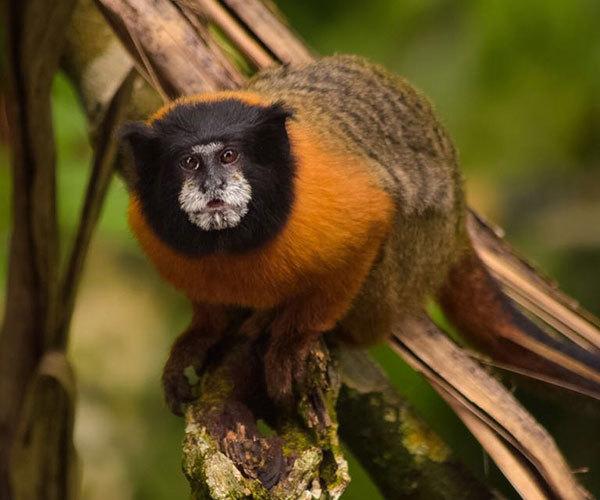 The Monk Saki (Pithecia monachus)
There are many species of Saki monkey who live in the Amazon. The more uncommon Monk Saki is of particular interest because of the variation in their coloration which changes over time. In general, they have very long and course hair which is primarily a grizzled gray-black with a stippling of white, light tan, and orange-brown tips in areas like the face and chest ruff. Their hands and feet are a mottled black and white, and they have a long, non-prehensile, bushy tail. Monk Sakis live in monogamous pairs in the upper canopy of the Terra firme forest. They are known as “flying monkeys” because they leap from one tree-top to another to eat fruit, leaves, and seeds.
The Monk Saki (Pithecia monachus)
There are many species of Saki monkey who live in the Amazon. The more uncommon Monk Saki is of particular interest because of the variation in their coloration which changes over time. In general, they have very long and course hair which is primarily a grizzled gray-black with a stippling of white, light tan, and orange-brown tips in areas like the face and chest ruff. Their hands and feet are a mottled black and white, and they have a long, non-prehensile, bushy tail. Monk Sakis live in monogamous pairs in the upper canopy of the Terra firme forest. They are known as “flying monkeys” because they leap from one tree-top to another to eat fruit, leaves, and seeds.
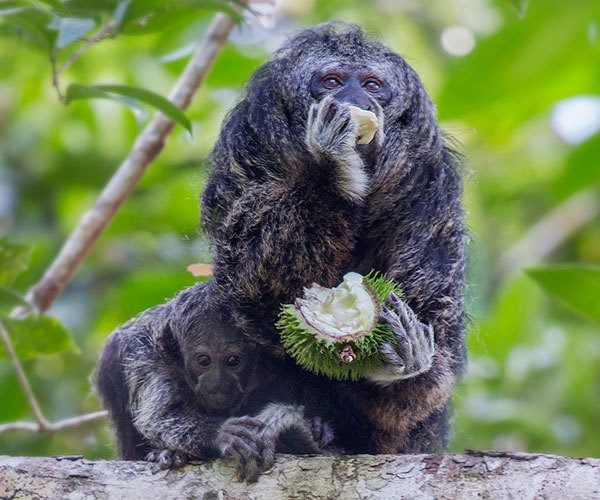 The South American Tapir (Tapirus terrestris)
Considered living fossils, these elusive herbivores have thrived here since the Eocene. They are the largest mammals in South America as they can weigh up to a hefty 300 kilograms. Their distinct prehensile snout is used to forage for enormous amounts of fruit from the time they begin their day at 3pm and throughout the night. One of the main forest floor ecosystems they inhabit is Aguajales which contains palm trees whose fruit are a staple of its diet. Due to a huge appetite and wide range, it is known as the “gardener of the forest” because all of the seeds it eats are dispersed along its travels through the underbrush. Tapir sightings are frequently possible at salt licks where they must visit periodically to obtain essential minerals.
The South American Tapir (Tapirus terrestris)
Considered living fossils, these elusive herbivores have thrived here since the Eocene. They are the largest mammals in South America as they can weigh up to a hefty 300 kilograms. Their distinct prehensile snout is used to forage for enormous amounts of fruit from the time they begin their day at 3pm and throughout the night. One of the main forest floor ecosystems they inhabit is Aguajales which contains palm trees whose fruit are a staple of its diet. Due to a huge appetite and wide range, it is known as the “gardener of the forest” because all of the seeds it eats are dispersed along its travels through the underbrush. Tapir sightings are frequently possible at salt licks where they must visit periodically to obtain essential minerals.
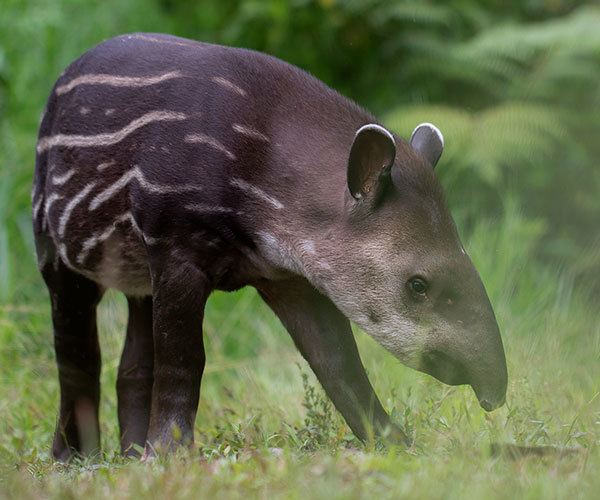 The Giant River Otter (Pteronura brasiliensis)
This is the world’s largest species of otter measuring up to 6 feet long and approximately 30 kilograms. They have brown, water-repellant fur which is accented with cream along the throat and chin. They live in families of up to 15 individuals consisting of a monogamous pair of parents and their litters of offspring. This carnivorous animal hunts alone or in tandem with their group by using coordinated hunting techniques. Each individual needs upwards of 2 kilograms of food per day, so their webbed feet (which make them very agile in the water) as well as sensitive whiskers (which detect changes in the water pressure and current) are essential to their success. Their diet mainly includes crustaceans and fish such as piranhas, as well as the occasional snake, turtle, or small caiman alligator. Because they are known to be very territorial and fearless, they are affectionately known as the “river wolf” or “aquatic jaguar”.
The Giant River Otter (Pteronura brasiliensis)
This is the world’s largest species of otter measuring up to 6 feet long and approximately 30 kilograms. They have brown, water-repellant fur which is accented with cream along the throat and chin. They live in families of up to 15 individuals consisting of a monogamous pair of parents and their litters of offspring. This carnivorous animal hunts alone or in tandem with their group by using coordinated hunting techniques. Each individual needs upwards of 2 kilograms of food per day, so their webbed feet (which make them very agile in the water) as well as sensitive whiskers (which detect changes in the water pressure and current) are essential to their success. Their diet mainly includes crustaceans and fish such as piranhas, as well as the occasional snake, turtle, or small caiman alligator. Because they are known to be very territorial and fearless, they are affectionately known as the “river wolf” or “aquatic jaguar”.
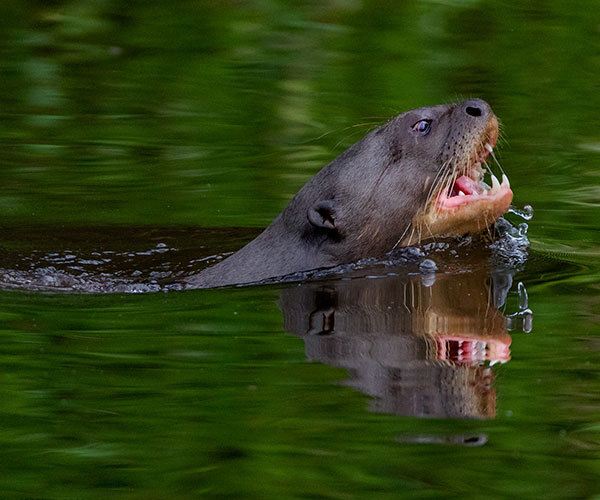 The Jaguar (Panthera onca)
This feline is the largest in South America measuring up to 6 feet and ranging in weight from 45 to 100 kilograms. Their fur is usually a beautiful mixture of tan and orange with striking black spots and rosettes. Unlike many other big cats, their diet is very opportunistic as they can hunt both on land and in rivers. Jaguars are good swimmers who prey on fish, turtles, caiman, and the occasional otter in addition to deer, peccaries, capybaras, tapirs, and any other creature they are able to catch. Though they are usually solitary animals, litters of 1 to 4 cubs must stay with their mother for approximately two years in order to become skilled hunters. Majestic jaguars are believed to be ancestral spirits who guide local shamans to areas of the forest where an abundance of food can be harvested.
The Jaguar (Panthera onca)
This feline is the largest in South America measuring up to 6 feet and ranging in weight from 45 to 100 kilograms. Their fur is usually a beautiful mixture of tan and orange with striking black spots and rosettes. Unlike many other big cats, their diet is very opportunistic as they can hunt both on land and in rivers. Jaguars are good swimmers who prey on fish, turtles, caiman, and the occasional otter in addition to deer, peccaries, capybaras, tapirs, and any other creature they are able to catch. Though they are usually solitary animals, litters of 1 to 4 cubs must stay with their mother for approximately two years in order to become skilled hunters. Majestic jaguars are believed to be ancestral spirits who guide local shamans to areas of the forest where an abundance of food can be harvested.
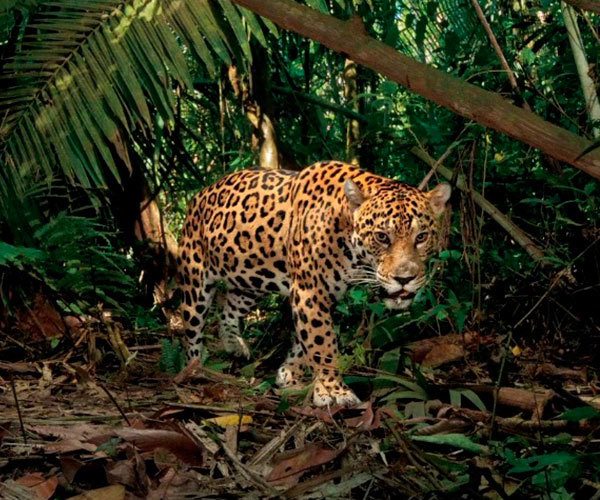 Diego Escobar is Marketing Director at Napo Wildlife Center. Napo Wildlife Center is an eco-lodge offering unforgettable experiences in the Amazon rainforest of Ecuador, inside Yasuni Biosphere Reserve, which is managed by the Añangu kichwa aboriginal community.
If you would like to be a guest blogger on A Luxury Travel Blog in order to raise your profile, please contact us.
Diego Escobar is Marketing Director at Napo Wildlife Center. Napo Wildlife Center is an eco-lodge offering unforgettable experiences in the Amazon rainforest of Ecuador, inside Yasuni Biosphere Reserve, which is managed by the Añangu kichwa aboriginal community.
If you would like to be a guest blogger on A Luxury Travel Blog in order to raise your profile, please contact us.Did you enjoy this article?
Receive similar content direct to your inbox.


All are stunning Diego but the jaguar is absolutely gorgeous! Fave big cat and animal as a little kid. Still holds true today. I recall my wife being in Iquitos, staying in a spot where jaguar had been spotted. Or their prints were ;) Pretty much a ghost making then effective hunters.
Thanks for sharing :)
Ryan